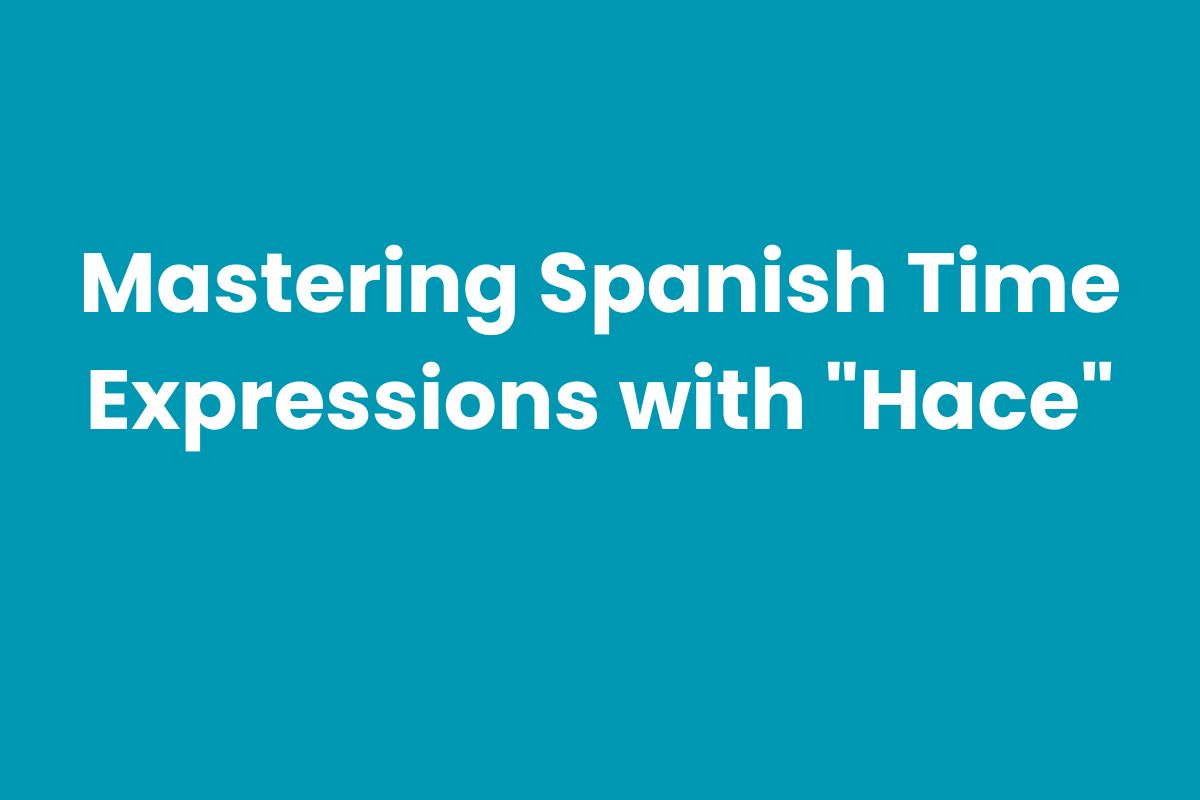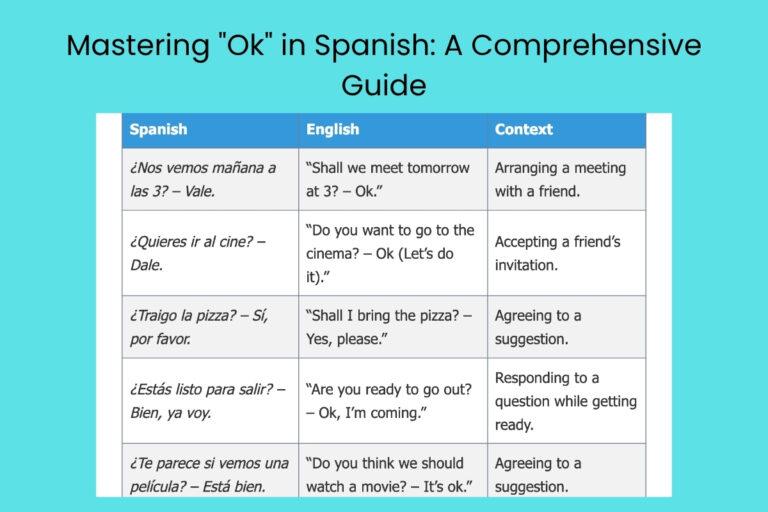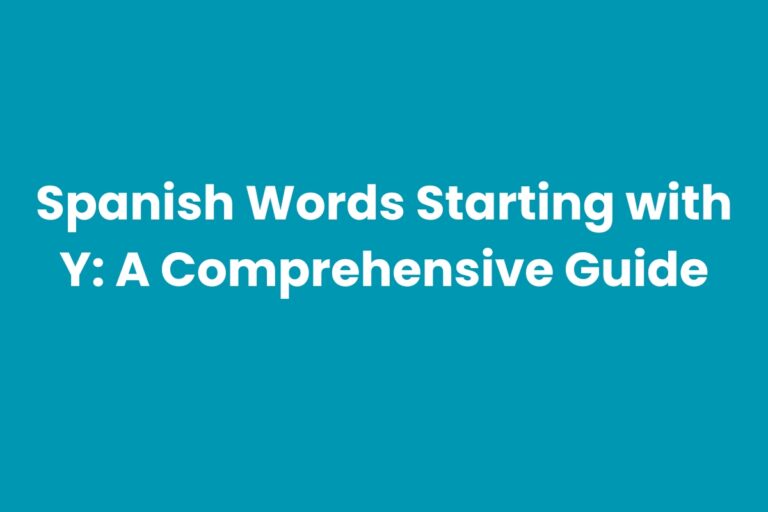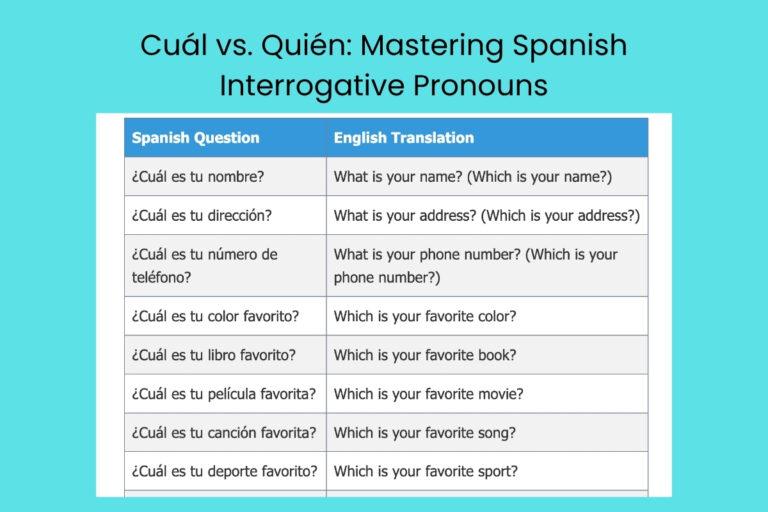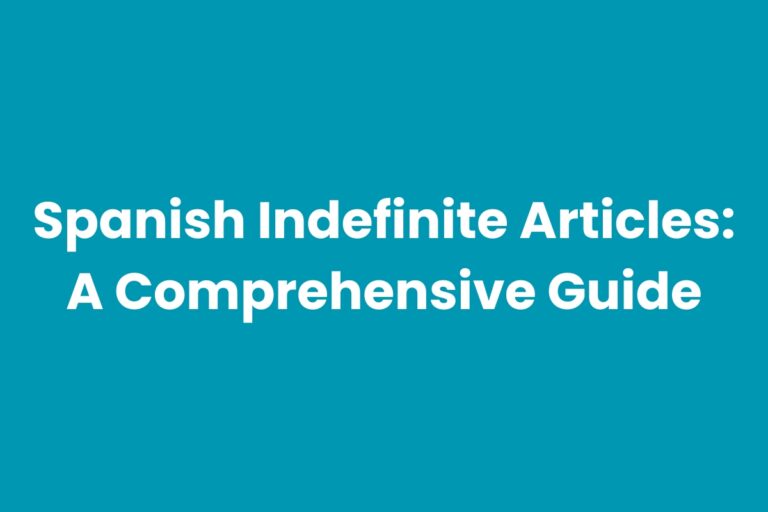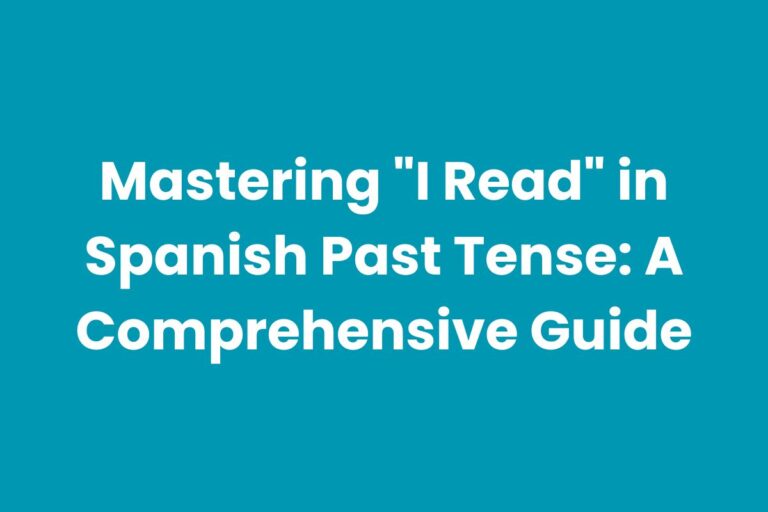Mastering Spanish Time Expressions with “Hace”
Understanding how to use “hace” to express time in Spanish is crucial for describing events that occurred in the past relative to the present. This construction serves as a fundamental building block for discussing durations, past actions, and experiences.
This article aims to provide a comprehensive guide for English speakers learning Spanish, focusing on the various ways “hace” is used, common errors to avoid, and practical exercises to solidify your understanding. Whether you’re a beginner or an advanced learner, this guide will help you confidently and accurately use “hace” in your Spanish conversations and writing.
Definition of “Hace” in Time Expressions
In Spanish, “hace” is a versatile word used to express time, specifically to indicate how long ago something happened. It’s derived from the verb “hacer” (to do or to make), but in this context, it functions as an impersonal verb indicating the passage of time.
The core function of “hace” in time expressions is to pinpoint when an event occurred relative to the present moment. It essentially answers the question, “How long ago?” or “How much time has passed?”.
This construction is essential for narrating past events, describing durations, and providing context for ongoing situations.
The grammatical classification of “hace” in these constructions is that of an impersonal verb. This means it doesn’t conjugate according to a specific subject; it remains in its third-person singular form. The function of the “hace” construction is adverbial, modifying the verb to indicate time. Contextually, “hace” is most often used when talking about past events or durations that are relevant to the present. For instance, discussing how long you’ve lived in a city, when you last saw a friend, or how long ago an event occurred all rely on the correct usage of “hace.”
Understanding “hace” is fundamental because it bridges the present and the past, allowing speakers to connect events in time. Without it, expressing durations and past occurrences would be significantly more complex and less precise.
It’s a cornerstone of Spanish grammar that enables clear and concise communication about time.
Structural Breakdown
Elements of the “Hace” Construction
The basic structure for using “hace” to express time is relatively straightforward. It typically involves three key components:
- “Hace”: The impersonal verb, always in the third-person singular form.
- Time Period: The duration of time that has passed (e.g., dos días, un año, cinco minutos).
- Event/Action: The verb describing the event or action that occurred in the past. This is often in the preterite (simple past) or imperfect tense.
Sometimes, the construction also includes the word “que” to connect the time expression with a clause describing the action.
Word Order
The most common word order for “hace” constructions is:
Hace + Time Period + que + Verb in Past Tense + Subject (optional)
Or, when the subject is specified at the beginning of the sentence:
Subject + Verb in Past Tense + hace + Time Period
Here’s a table illustrating the word order with examples:
| Word Order | Example (Spanish) | Example (English) |
|---|---|---|
| Hace + Time Period + que + Verb in Past Tense | Hace dos años que visité España. | It’s been two years since I visited Spain. |
| Subject + Verb in Past Tense + hace + Time Period | Visité España hace dos años. | I visited Spain two years ago. |
| Hace + Time Period + Verb in past tense (no “que”) | Hace cinco minutos llegué. | I arrived five minutes ago. |
Note that the placement of the subject can vary depending on emphasis and sentence structure, but the core components of “hace” and the time period remain central to the construction.
Types and Categories of “Hace” Time Expressions
The “hace” construction can be broadly categorized into two main types based on its function:
Describing Past Events
This category refers to using “hace” to indicate when a specific event occurred in the past. The focus is on pinpointing a moment in time relative to the present.
The verb describing the event is usually in the preterite or imperfect tense, depending on whether it’s a completed action or a habitual action in the past.
Indicating Durations
This category involves using “hace” to specify how long ago an action or state began and continues up to the present. It answers the question of how much time has elapsed since something started.
This often involves the present perfect tense in English, but Spanish uses “hace” with the present tense to express the same idea.
Here’s a table summarizing the two categories:
| Category | Function | Tense | Example (Spanish) | Example (English) |
|---|---|---|---|---|
| Past Events | Indicate when an event occurred in the past | Preterite/Imperfect | Hace un mes fui al cine. | I went to the cinema a month ago. |
| Durations | Specify how long ago an action began and continues | Present | Hace dos años que vivo aquí. | I have been living here for two years. |
Examples of “Hace” in Various Contexts
To further illustrate the use of “hace”, let’s examine various examples categorized by the type of time expression.
Past Events Examples
These examples showcase “hace” used to indicate when a specific event took place in the past. The preterite tense is commonly used to describe completed actions.
| Spanish Sentence | English Translation |
|---|---|
| Hace un año que compré mi coche. | I bought my car a year ago. |
| Hace tres días que vi a Juan. | I saw Juan three days ago. |
| Hace una semana que llegó mi paquete. | My package arrived a week ago. |
| Hace dos meses que empecé a estudiar español. | I started studying Spanish two months ago. |
| Hace cinco minutos que sonó el teléfono. | The phone rang five minutes ago. |
| Hace un siglo que construyeron este edificio. | They built this building a century ago. |
| Hace unas horas que comimos. | We ate a few hours ago. |
| Hace mucho tiempo que no te veía. | I haven’t seen you in a long time. |
| Hace poco que se mudaron a esta ciudad. | They moved to this city recently. |
| Hace un momento que salió. | He/She left a moment ago. |
| Hace quince días que terminé el libro. | I finished the book two weeks ago. |
| Hace varios años que conocí a mi esposo. | I met my husband several years ago. |
| Hace un mes que celebramos su cumpleaños. | We celebrated his/her birthday a month ago. |
| Hace dos semanas que viajamos a la playa. | We traveled to the beach two weeks ago. |
| Hace diez minutos que empezó la película. | The movie started ten minutes ago. |
| Hace tres años que me gradué de la universidad. | I graduated from university three years ago. |
| Hace una semana que compré estos zapatos. | I bought these shoes a week ago. |
| Hace cinco días que envié el correo. | I sent the email five days ago. |
| Hace un año que visitamos París. | We visited Paris a year ago. |
| Hace seis meses que me cambié de trabajo. | I changed jobs six months ago. |
| Hace un rato que llamé a mi madre. | I called my mother a little while ago. |
| Hace dos días que llovió. | It rained two days ago. |
| Hace tres semanas que fuimos al teatro. | We went to the theater three weeks ago. |
Duration Examples
These examples demonstrate using “hace” to indicate how long an action or state has been ongoing. Note the use of the present tense in Spanish to convey the duration.
| Spanish Sentence | English Translation |
|---|---|
| Hace cinco años que vivo en esta ciudad. | I have been living in this city for five years. |
| Hace dos meses que estudio español. | I have been studying Spanish for two months. |
| Hace una hora que estoy esperando. | I have been waiting for an hour. |
| Hace mucho tiempo que no veo a mi familia. | I haven’t seen my family for a long time. |
| Hace tres semanas que trabajo en esta empresa. | I have been working at this company for three weeks. |
| Hace diez años que conozco a mi mejor amigo. | I have known my best friend for ten years. |
| Hace un año que tengo este perro. | I have had this dog for a year. |
| Hace seis meses que estoy aprendiendo a tocar la guitarra. | I have been learning to play the guitar for six months. |
| Hace varios días que no duermo bien. | I haven’t been sleeping well for several days. |
| Hace poco que empezamos a salir. | We started dating recently. (We have been dating for a short time.) |
| Hace quince minutos que estoy en la reunión. | I have been in the meeting for fifteen minutes. |
| Hace varios meses que estoy ahorrando para un coche nuevo. | I have been saving for a new car for several months. |
| Hace un año que estoy trabajando desde casa. | I have been working from home for a year. |
| Hace dos semanas que estoy leyendo este libro. | I have been reading this book for two weeks. |
| Hace diez minutos que está cocinando la cena. | He/She has been cooking dinner for ten minutes. |
| Hace tres años que soy miembro de este club. | I have been a member of this club for three years. |
| Hace una semana que estoy haciendo dieta. | I have been on a diet for a week. |
| Hace cinco días que estoy esperando su respuesta. | I have been waiting for his/her response for five days. |
| Hace un año que estamos casados. | We have been married for a year. |
| Hace seis meses que estoy estudiando para este examen. | I have been studying for this exam for six months. |
| Hace un rato que estoy escuchando música. | I have been listening to music for a little while. |
| Hace dos días que no veo la televisión. | I haven’t watched television for two days. |
| Hace tres semanas que estoy aprendiendo a bailar salsa. | I have been learning to dance salsa for three weeks. |
“Hace Que” Examples
The “hace que” construction is particularly useful for connecting the time expression directly to the action. It clearly establishes the relationship between the duration and the event.
| Spanish Sentence | English Translation |
|---|---|
| Hace dos días que no como carne. | I haven’t eaten meat for two days. |
| Hace un mes que no voy al gimnasio. | I haven’t been to the gym for a month. |
| Hace tres horas que estoy trabajando en este proyecto. | I have been working on this project for three hours. |
| Hace cinco minutos que empezó la reunión. | The meeting started five minutes ago. |
| Hace un año que me mudé a esta casa. | I moved to this house a year ago. |
| Hace seis meses que estoy buscando trabajo. | I have been looking for a job for six months. |
| Hace varios días que no veo el sol. | I haven’t seen the sun for several days. |
| Hace poco que llegué a la fiesta. | I arrived at the party recently. |
| Hace quince años que vivo en este país. | I have been living in this country for fifteen years. |
| Hace varios meses que estamos planeando las vacaciones. | We have been planning the vacation for several months. |
| Hace un año que terminé mis estudios. | I finished my studies a year ago. |
| Hace dos semanas que estoy esperando el paquete. | I have been waiting for the package for two weeks. |
| Hace diez días que estoy enfermo. | I have been sick for ten days. |
| Hace tres años que no viajo al extranjero. | I haven’t traveled abroad for three years. |
| Hace una semana que estoy leyendo este libro. | I have been reading this book for a week. |
| Hace cinco días que estoy aprendiendo a cocinar. | I have been learning to cook for five days. |
| Hace un año que estoy ahorrando dinero. | I have been saving money for a year. |
| Hace seis meses que estoy practicando yoga. | I have been practicing yoga for six months. |
| Hace varios días que no hablo con mi hermano. | I haven’t spoken to my brother for several days. |
| Hace poco que compré esta computadora. | I bought this computer recently. |
| Hace quince minutos que estoy esperando el autobús. | I have been waiting for the bus for fifteen minutes. |
| Hace varios meses que estoy pensando en cambiarme de casa. | I have been thinking about moving for several months. |
Usage Rules for “Hace”
Several rules govern the proper use of “hace” in time expressions, ensuring clarity and grammatical accuracy.
Agreement and Gender
“Hace” is an impersonal verb, meaning it does not change to agree with gender or number. It always remains in the third-person singular form, regardless of the subject or time period.
Tense Considerations
When using “hace” to describe past events, the verb describing the event is typically in the preterite (simple past) or imperfect tense. The choice depends on whether the action is completed or habitual. When indicating durations, the verb is usually in the present tense.
Prepositions
In most cases, you do not need to use prepositions with “hace” and time expressions. The structure “hace + time period” is usually sufficient. However, remember to use “que” to connect the time expression to a clause describing the action.
Here’s a summary table of the usage rules:
| Rule | Description | Example (Spanish) | Example (English) |
|---|---|---|---|
| Agreement | “Hace” does not change form. | Hace cinco años. | Five years ago. |
| Tense (Past Events) | Use preterite or imperfect tense. | Hace un mes fui al teatro. | I went to the theater a month ago. |
| Tense (Durations) | Use present tense. | Hace dos años que vivo aquí. | I have been living here for two years. |
| Prepositions | Generally, no prepositions are needed. | Hace tres días que llegó. | He/She arrived three days ago. |
Common Mistakes with “Hace”
Learners often make specific mistakes when using “hace.” Recognizing these errors and understanding their corrections is key to mastering the construction.
Incorrect Tense Usage
One common mistake is using the past tense to describe a duration that extends to the present. Remember to use the present tense in Spanish in this case.
| Incorrect | Correct | Explanation |
|---|---|---|
| Hace cinco años viví en esta ciudad. | Hace cinco años que vivo en esta ciudad. | The incorrect sentence implies you lived in the city for five years and no longer do. The correct sentence means you have been living there for five years and still do. |
Wrong Preposition
Another common mistake is adding unnecessary prepositions. “Hace” usually doesn’t require additional prepositions before the time period.
| Incorrect | Correct | Explanation |
|---|---|---|
| Hace de dos días que llegué. | Hace dos días que llegué. | The preposition “de” is unnecessary. The correct sentence directly states that it has been two days since you arrived. |
Here are more examples of common mistakes:
| Mistake Type | Incorrect Spanish | Correct Spanish | English Translation |
|---|---|---|---|
| Tense Confusion | Hace un año que compraba mi coche. | Hace un año que compré mi coche. | I bought my car a year ago. |
| Unnecessary Preposition | Hace desde dos meses que estudio español. | Hace dos meses que estudio español. | I have been studying Spanish for two months. |
| Incorrect Word Order | Yo visité España hace dos años. | Visité España hace dos años. | I visited Spain two years ago. (While the first sentence is not grammatically *incorrect*, the second is more natural) |
| Incorrect “hacer” conjugation | Hago dos años que vivo aquí | Hace dos años que vivo aquí | I have been living here for two years. |
Practice Exercises
To solidify your understanding of “hace,” complete the following exercises.
Exercise 1: Fill in the Blanks
Fill in the blanks with the correct form of “hace” and the missing words to complete the sentence.
| Question | Answer |
|---|---|
| 1. _________ tres días ___________ fui al supermercado. | Hace tres días que fui al supermercado. |
| 2. _________ un año ___________ vivo en España. | Hace un año que vivo en España. |
| 3. _________ cinco minutos ___________ sonó el teléfono. | Hace cinco minutos que sonó el teléfono. |
| 4. _________ mucho tiempo ___________ no te veo. | Hace mucho tiempo que no te veo. |
| 5. _________ dos semanas ___________ empecé a trabajar aquí. | Hace dos semanas que empecé a trabajar aquí. |
| 6. _________ diez años ___________ conozco a mi mejor amigo. | Hace diez años que conozco a mi mejor amigo. |
| 7. _________ un mes ___________ compré un libro nuevo. | Hace un mes que compré un libro nuevo. |
| 8. _________ tres horas ___________ estoy esperando el autobús. | Hace tres horas que estoy esperando el autobús. |
| 9. _________ varios días ___________ no llueve. | Hace varios días que no llueve. |
| 10. _________ poco tiempo ___________ llegué a la fiesta. | Hace poco tiempo que llegué a la fiesta. |
Exercise 2: Translation
Translate the following English sentences into Spanish using “hace.”
| English Sentence | Spanish Translation |
|---|---|
| 1. I bought this computer two weeks ago. | Hace dos semanas que compré esta computadora. |
| 2. I have been studying French for six months. | Hace seis meses que estudio francés. |
| 3. He arrived five minutes ago. | Hace cinco minutos que llegó. |
| 4. We haven’t seen them for a long time. | Hace mucho tiempo que no los vemos. |
| 5. She started working here a year ago. | Hace un año que empezó a trabajar aquí. |
| 6. I have known her for ten years. | Hace diez años que la conozco. |
| 7. I ate breakfast an hour ago. | Hace una hora que desayuné. |
| 8. We have been waiting for you for three hours. | Hace tres horas que te estamos esperando. |
| 9. It hasn’t rained for several days. | Hace varios días que no llueve. |
| 10. I arrived at the party recently. | Hace poco que llegué a la fiesta. |
Exercise 3: Sentence Construction
Construct sentences using “hace” with the given prompts.
| Prompt | Possible Sentence |
|---|---|
| 1. Estudiar inglés / dos años | Hace dos años que estudio inglés. |
| 2. Visitar Madrid / un mes | Hace un mes que visité Madrid. |
| 3. Llamar a mi madre / ayer | Hace un día que llamé a mi madre. (or Hace un día que llamé a mi mamá) |
| 4. Trabajar aquí / cinco años | Hace cinco años que trabajo aquí. |
| 5. Comer / dos horas | Hace dos horas que comí. |
| 6. Ver esa película / una semana | Hace una semana que vi esa película. |
| 7. Vivir en esta casa / diez años | Hace diez años que vivo en esta casa. |
| 8. Conocer a Juan / un año | Hace un año que conozco a Juan. |
| 9. Comprar este libro / tres semanas | Hace tres semanas que compré este libro. |
| 10. Empezar a correr / un mes | Hace un mes que empecé a correr. |
Advanced Topics with “Hace”
For advanced learners, exploring more nuanced aspects of “hace” can further enhance their fluency and accuracy.
“Hace Que” Construction in Detail
The “hace que” construction is particularly useful for emphasizing the duration and its direct relationship to the action. It is more common and often preferred over simply using “hace + time period + verb.” This construction provides a clearer and more natural flow to the sentence, making it easier to understand the connection between the time elapsed and the event.
For example, comparing “Hace dos años visité España” and “Hace dos años que visité España,” the latter is generally preferred because the “que” explicitly links the two-year duration to the act of visiting Spain.
Idiomatic Expressions with “Hace”
Spanish also features idiomatic expressions using “hace” that don’t directly translate word-for-word. These expressions often convey specific meanings or nuances that require a more contextual understanding.
For example:
- “Hace un frío que pela”: It’s freezing cold (literally, “It makes a cold that peels”).
- “Hace buen tiempo/mal tiempo”: The weather is good/bad (literally, “It makes good time/bad time”).
Understanding these idioms can add color and authenticity to your Spanish conversations.
Frequently Asked Questions (FAQ)
- Q: Is “hace” always used with the past tense?
A: No, “hace” is used with the past tense (preterite or imperfect) when describing an event that occurred in the past. However, when indicating a duration that continues to the present, “hace” is used with the present tense.
- Q: Can I use “hace” to talk about future events?
A: No, “hace” is exclusively used to refer to past events or durations leading up to the present. For future events, you would use other time expressions like “dentro de” or “en.”
- Q: What’s the difference between “hace” and “desde hace”?
A: “Hace” indicates how long ago something happened. “Desde hace” also indicates duration, but it often emphasizes the starting point. While “Hace dos años que vivo aquí” means “I have been living here for two years,” “Vivo aquí desde hace dos años” means “I have been living here since two years ago,” highlighting the starting point two years ago.
- Q: Do I always need to use “que” with “hace”?
A: While not always grammatically required, using “que” often improves the flow and clarity of the sentence, especially when connecting the time expression to a clause. It’s generally recommended, particularly for learners.
- Q: Can I use “hace” with any verb tense?
A: “Hace” is primarily used with the preterite, imperfect, and present tenses. The preterite and imperfect are used for past events, while the present tense is used to describe actions that started in the past and continue to the present. Other tenses are generally not used with “hace.”
- Q: How do I say “ago” in Spanish?
A: “Hace” is the most common and direct translation of “ago” in Spanish when referring to time. For example, “Two years ago” is “Hace dos años.”
- Q: Is it correct to say “Hace que… + subjunctive”?
A: No, the “hace que” construction typically doesn’t use the subjunctive mood. It’s used with the indicative mood to describe factual events or durations.
- Q: What if I want to say “for” a certain amount of time in the past (not leading up to the present)?
A: In this case, you would use “durante” (during) or “por” (for) with the past tense. For example, “I lived in Spain for two years” would be “Viví en España durante dos años” or “Viví en España por dos años.”
- Q: Can I use “hace” with reflexive verbs?
A: Yes, you can use “hace” with reflexive verbs. The structure remains the same, but you need to ensure the reflexive pronoun agrees with the subject. For example, “Hace cinco años que me casé” (I got married five years ago).
- Q: What are some other ways to express time in Spanish besides using “hace”?
A: Besides “hace,” you can use expressions like “en” (in), “dentro de” (within), “después de” (after), “antes de” (before), “desde” (since), and “durante” (during) to express time in Spanish. Each expression has its specific usage and context.
Conclusion
Mastering the use of “hace” in Spanish time expressions is essential for expressing when events occurred and for indicating durations. By understanding the structural elements, usage rules, and common mistakes associated with “hace”, learners can significantly improve their fluency and accuracy in Spanish.
Remember to practice regularly with examples and exercises to solidify your understanding of this crucial grammar concept.
Continue to practice using “hace” in various contexts, and don’t be afraid to make mistakes – they are a natural part of the learning process. The more you use “hace” in your conversations and writing, the more comfortable and confident you will become.
With consistent effort and attention to detail, you’ll master this essential aspect of Spanish grammar and
confidently express time in your Spanish communication.

